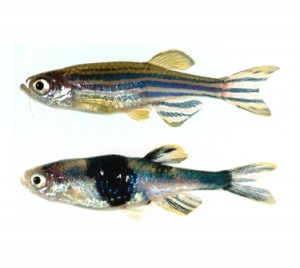The zebrafish (Danio rerio to the taxonomists) is a striped tropical fish, no longer than your pinky finger, that looks like it would be more at home in someone’s aquarium than in a laboratory. But for several reasons, zebrafish are powerful organisms for stem cell, developmental, and genetic research:
- Despite our distance from zebrafish on the evolutionary tree, they’re surprisingly similar to us from a genetic standpoint.
- Because of their small size, they can be housed at high densities.
- Compared to other model organisms like mice, they’re relatively inexpensive to care for.
- An adult female zebrafish can lay 300 eggs each week. By comparison, a mouse might have a single 12-pup litter each month.
- Their skin is permeable, so they can absorb drugs directly from the water of their tank.
- Zebrafish embryos are transparent, offering a window into their bodies; some lines, like Casper, remain transparent through adulthood.
Richard White, a zebrafish researcher at Children’s and Dana-Farber Cancer Institute, explains all the characteristics that make zebrafish popular among genetic and stem cell researchers in particular:
One can roughly gauge the fish’s effectiveness as a research tool with a quick search of PubMed: The database records more than 14,500 references to zebrafish, dating as far back as 1955.
Zebrafish research’s prominence at Children’s dates to the 1990s, when Leonard Zon, now director of the Children’s Stem Cell Research Program, started using them heavily to study GATA-1, a factor that boosts stem cell development. “For eight years I worked first in the mouse and then the frog, to determine how GATA-1 was induced in embryos,” Zon recalls. “Then, a number of events converged to take me in a different direction. At a conference, one of my competitors suggested that zebrafish might be a good system for understanding the genetics of stem cell regulation. Then, a scientist who had expertise with Antarctic fish asked to join my group, and a friend from Harvard called with a zebrafish mutant that couldn’t make blood, to ask if I wanted to work on it.”
Today the fish occupy roughly 10,000 tanks and 5,000 square feet of space in the Karp Family Research Laboratories. Joanne Chan, of our Vascular Biology Program, uses them to understand how the circulatory system develops – a window into angiogenesis, a process significantly relevant to tumor growth and development. The Newborn Medicine Division’s Farhad Imam looks to zebrafish to understand fetal robustness, gaining insights into how to improve the ways in which we care for infants born prematurely. Members of the Stem Cell Research Program are using them to plumb the biology of melanoma, leukemia, and lung cancer.
Researchers are starting to reel in some big ones. Zebrafish pointed Zon’s laboratory to another factor for boosting blood stem cells for stem cell transplants: by treating umbilical cord blood with a drug called prostaglandin E2 (a technique that is currently in clinical trials).
Last week, using a zebrafish model of melanoma developed in his lab six years ago, Zon announced the identification of both a new melanoma-causing gene, SETDB1 – the first be discovered using this model – and a new potential treatment regimen that includes a drug already on the market for treating forms of arthritis. “It was truly a brute-force scientific effort to home in on SETDB1,” said Zon. “Between discovery and validation, we ultimately assayed more than 3,100 fish.”
And in mid March, Louis Kunkel, director of the Program in Genomics, published a study where he and his colleagues used the fish to find a drug that might circumvent the genetic error that gives rise to Duchenne muscular dystrophy (DMD).
“The zebrafish have turned out to be ideal for this kind of small-molecule screening in DMD,” Kunkel noted. “Because we can grow and test so many at a time, we were able to screen 1,200 chemicals very quickly. We are already screening a few thousand more chemicals, and because we’re focusing on ones that have already been approved for human use, we are confident that we will be able to take candidates found in the fish quickly through mouse studies and into the clinic.”
![fish in well image[1]](../../../wp-content/uploads/2011/03/fish-in-well-image1-300x235.jpg)









